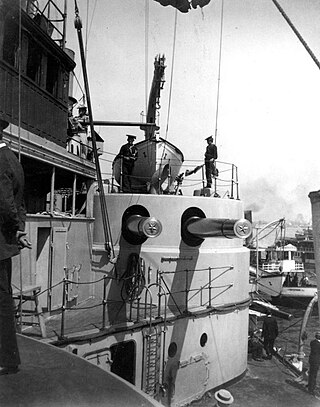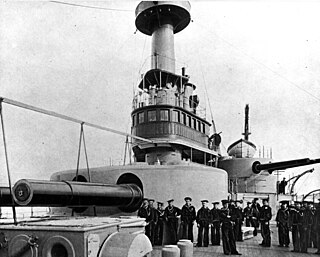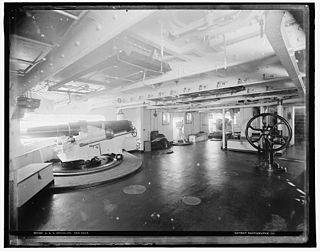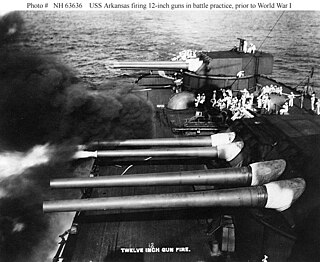
The 4″/50 caliber gun was the standard low-angle, quick-firing gun for United States, first appearing on the monitor Arkansas and then used on "Flush Deck" destroyers through World War I and the 1920s. It was also the standard deck gun on S-class submarines, and was used to rearm numerous submarines built with 3-inch (76 mm) guns early in World War II. United States naval gun terminology indicates the gun fired a projectile 4 inches (100 mm) in diameter, and the barrel was 50 calibers long.

The 14"/45 caliber gun,, whose variations were known initially as the Mark 1, 2, 3, and 5, and, when upgraded in the 1930s, were redesignated as the Mark 8, 9, 10, and 12. They were the first 14-inch (356 mm) guns to be employed with the United States Navy. The 14-inch/45 caliber guns were installed as the primary armament aboard all of the United States Navy's New York-class, Nevada-class, and Pennsylvania-class battleships. The gun also saw service in the British Royal Navy, where it was designated the BL 14 inch gun Mk II.

The 14"/50 caliber gun was a naval gun mounted on New Mexico and Tennessee-class battleships. These ships also featured the first "three-gun" turrets, meaning that each gun in each turret could be "individually sleeved" to elevate separately. The 14"/50 caliber guns were designated as Mark 4 and 6, with later versions known as Mark 7, 11, and B. These guns were more powerful than the main gun mounted on the previous three classes of US battleships, the 14"/45 caliber gun.

The 6"/53 caliber gun formed the main battery of some United States Navy light cruisers and three US submarines built during the 1920s.

The 8"/30 caliber gun formed the main batteries of the United States Navy's "New Navy". They were a US naval gun that first entered service in 1886, and were designed for use with the first three protected cruisers, Atlanta, Boston and Chicago.

The 8"/35 caliber gun Mark 3 and Mark 4 were used for the main batteries of the United States Navy's first armored cruisers and the secondary batteries for their first battleships, the Indiana-class. The 8"/40 caliber gun Mark 5 initially armed the Pennsylvania-class armored cruisers.

The 12"/35 caliber gun were used for the primary batteries of the United States Navy's "New Navy" monitors Puritan and Monterey and the battleships Texas and Iowa.

The 8"/45 caliber Mark 6 gun were used for the secondary batteries of the United States Navy's last pre-dreadnought battleships and refitted in older armored cruisers main batteries.

The 12"/40 caliber gun were used for the primary batteries of the United States Navy's last class of monitors and the Maine-class and Virginia-class pre-dreadnought battleships.

The 10"/40 caliber gun Mark 3 was used for the main batteries of the United States Navy's last generation of armored cruisers, the Tennessee-class. The Mark 3s were the last, and most powerful, 10-inch (254 mm) guns built for the US Navy.

The 7"/44 caliber gun Mark 1 and 7"/45 caliber gun Mark 2 were used for the secondary batteries of the United States Navy's last generation of pre-dreadnought battleships, the Connecticut-class and Mississippi-class. The 7-inch (178 mm) caliber was considered, at the time, to be the largest caliber weapon suitable as a rapid-fire secondary gun because its shells were the heaviest that one man could handle alone.

The 6"/30 caliber gun Mark 1 were used for the primary battery of the United States Navy's dispatch vessel Dolphin with the Mark 2 being used in the secondary batteries for its "New Navy" protected cruisers Atlanta, Chicago, and Boston and the Mark 3 used for the primary and secondary batteries in the succeeding early protected cruisers in addition to secondary batteries in the "Second Class Battleships" Maine and Texas.

The 6"/40 caliber gun Mark 4 were used for the secondary batteries of the United States Navy's Indiana-class and Illinois-class battleships. They were also used as the main battery on the Cincinnati-class protected cruisers.

The 13"/35 caliber gun Mark 1 was used for the primary batteries on eight of the first nine battleships in the United States Navy, Indiana-class, Kearsarge-class and Illinois-class; USS Iowa (BB-4) used the 12-inch (305 mm)/35 caliber gun.

The 4"/40 caliber gun was used for the secondary batteries on the United States Navy's battleship Iowa, Columbia-class protected cruisers, and the armored cruiser New York, and was the primary batteries on the gunboats Nashville, Wilmington, and Helena.
The 5"/31 caliber gun were used in the secondary batteries of the United States Navy's "New Navy" protected cruiser Chicago and later mounted in Panther during the Spanish–American War.

The 5″/40 caliber gun were used in the secondary batteries of the United States Navy's early battleships, armored cruisers, protected cruisers, unprotected cruisers, and auxiliary cruisers.

The 5"/50 caliber gun was the first long barrel 5-inch (127 mm) gun of the United States Navy and was used in the secondary batteries of the early Delaware-class dreadnought battleships, various protected cruisers, and scout cruisers. They were also refitted in the secondary batteries of the armored cruiser New York and the New Orleans-class protected cruisers. They were later used on cargo ships, store ships and unclassified auxiliaries during World War II as well as in emergency coastal defense batteries.

The 12"/50 caliber Mark 7 gun was a United States Navy's naval gun that first entered service in 1912. Initially designed for use with the Wyoming-class of dreadnought battleships, the Mark 7 also armed the Argentine Navy's Rivadavia-class battleships.

The 6"/50 caliber gun Mark 6 and Mark 8 were used for the secondary batteries of the United States Navy's Maine-class and Virginia-class battleships, as well as the Pennsylvania-class and Tennessee-class armored cruisers. They were also used as the main battery on the St. Louis-class protected cruisers.



















